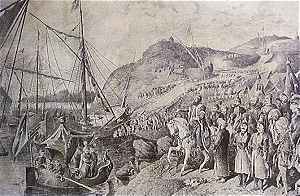|
 Alfred Hitchcock, that unforgettable director of horror films, always appeared in one scene of his films. This brief glimpse was his unique signature. In 1899, the year that Hitchcock was born, a Turkish artist portrayed himself among the figures in one of his paintings. This painting depicting the entry of Sultan Mehmed the Conqueror into Istanbul through Topkapi Gate in 1453 is familiar to many people in Turkey from reproductions in history books. Beside the grey horse on which the sultan is mounted walks a janissary holding a long- barrelled gun. This janissary is the artist Hasan Rıza (1857-1912), a colourful personality known for his wit and humour. It was quite in character for him to introduce a private joke of this kind into an otherwise serious painting. Alfred Hitchcock, that unforgettable director of horror films, always appeared in one scene of his films. This brief glimpse was his unique signature. In 1899, the year that Hitchcock was born, a Turkish artist portrayed himself among the figures in one of his paintings. This painting depicting the entry of Sultan Mehmed the Conqueror into Istanbul through Topkapi Gate in 1453 is familiar to many people in Turkey from reproductions in history books. Beside the grey horse on which the sultan is mounted walks a janissary holding a long- barrelled gun. This janissary is the artist Hasan Rıza (1857-1912), a colourful personality known for his wit and humour. It was quite in character for him to introduce a private joke of this kind into an otherwise serious painting.
Hasan Rıza was born in Üsküdar (Scutari), a district of Istanbul on the Asian shore of the Bosphorus. In his memoirs he relates that his passion for art began as a child, when he annoyed his parents by drawing pictures with a lump of charcoal on the wall of the house. Two wars were to play a crucial part in his life. The Ottoman- Russian War of 1877-1878 opened new doors for him, while the Balkan War closed them for ever.
During his final year at the Naval College on the island of Heybeliada, Hasan Rıza volunteered for service in the Ottoman-Russian War, and was sent as a private to join a regiment on the Russian frontier. There he was assigned as guard to an Italian journalist who was both reporting on the war and making masterful drawings of the battle scenes he witnessed that greatly impressed the young soldier. One day Hasan Rıza drew a charcoal portrait of the elderly journalist and showed it to him.
The journalist was surprised at this skill displayed by an ordinary soldier, and a friendship grew up between them. When the war ended and Hasan Rıza returned to the naval college, he frequently visited the Italian journalist, who was also living on Heybeliada, and under his fried'sd guidance improved his drawing skills. That same year Hasan Rıza was appointed to restore the paintings and decoration in the cabins of Sultan Abdülhamid's yacht, and performed the task so well that the minister of naval affairs made him an officer before he had even graduated. But Hasan Rıza was already determined to become an artist, and with the encouragement of the Italian journalist went to Italy as soon as he left college. For the next ten years he studied in the studios of various artists in Naples, Rome and Florence, and then travelled to Egypt, where he studied Egyptian art for two years.
After returning to Turkey he opened a studio in Karaagaç, a small town near Edirne, where he painted many portraits of famous people and a series of paintings depicting the foremost events and battles of Ottoman history. In the quiet atmosphere of Karaagaç he was able to devote himself to his work, and his output was prolific. Unfortunately, very few of his historical paintings have survived. Among the few in existence today are paintings of the Siege of Vienna and the Battle of Belgrade in the Military Museum, 'The Transportation of the Conqueror's Ships Overland before the Siege of Istanbul' and 'The Conqueror Marching with His Army from Edirne to Istanbul' in the Naval Museum, and the Siege of Eger and the Battle of Mohacs in Ankara Officers Club.
From his paintings it is clear that Hasan Rıza had an extensive knowledge of history, and his figures display a masterful grasp of anatomy. His sense of composition is evident in even the most confused battle scenes, which he depicted with realism. He worked in charcoal, Indian ink, pastel and oils. During his years in Edirne Hasan Rıza also served as headmaster of the city's art college, and trained many young people as artists. With the outbreak of the Balkan War, Hasan Rıza was put in charge of Edirne Hospital. When news was received that the Bulgarian army had entered the city, he set out for Karaagaç to rescue his paintings, but was killed on the way. Many of the paintings in his studio were destroyed or looted, some being taken to Sofia, and others turning up years later in Vienna Museum.
Those that remained were eventually brought back to Istanbul. As well as the six already mentioned, some can be seen in the Museum of Fine Arts in Istanbul, and a few are in private collections.
|